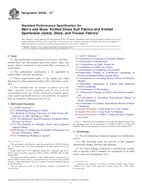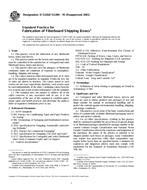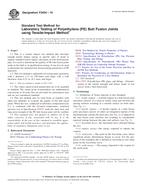1.1 This standard practice describes a hierarchical outline of sections and elements to be used in developing metadata to support archived data management systems. Specifically, the standard establishes the names of metadata elements and compound elements to be used in the metadata, the definitions of these metadata elements and compound elements, and suggested information about and examples of the values that are to be provided for the metadata elements.
1.2 The metadata to be developed using this standard includes qualitative and quantitative data that is associated with an information system or information object for the purposes of description, administration, legal requirements, technical functionality, use and usage, and preservation. As such, it can be differentiated from other metadata in that it describes and provides an interpretation of an organized collection of data, not a single data element.
1.3 This standard is intended for use by those developing, managing, or maintaining an archived data management system. For example, public agencies can specify that this standard be used in the development of a metadata framework for data archives. Data collectors and data processing intermediaries may also use this standard to create metadata describing the original collection conditions and intermediate processing steps. The development of metadata by data collectors and data processing intermediaries can greatly assist in the development of comprehensive metadata by the data archive manager. The standard is intended for use by all levels of government and the private sector.
1.4 This standard is applicable to various types of operational data collected by intelligent transportation systems (ITS) and stored in an archived data management system. Similarly, the standard can also be used with other types of historical traffic and transportation data collected and stored in an archived data management system.
1.5 This standard does not specify the means by which metadata is to be organized in a computer system or in a data transfer, nor the means by which metadata is to be transmitted, communicated, or presented to the user. Additionally, the standard is not intended to reflect or imply a specific implementation design. An implementation design requires adapting the structure and form of the standard to meet specific application and environment requirements.
1.6 This standard adopts with minimal changes the Federal Geographic Data Committees (FGDCs) existing Content Standard for Digital Geospatial Metadata (FGDC-STD-001-1998) as the recommended metadata framework for archived data management systems. The FGDC metadata standard was chosen as the framework because of its relevance and established reputation among the spatial data community. A benefit of using the FGDC standard is the widespread availability of informational resources and software tools to create, validate, and manage metadata (see http://www.fgdc.gov/metadata/links/metalinks.html). Commentary and several examples are provided in this standard to illustrate the use of the FGDC standard in the ITS domain. The detail of the standard may appear intimidating, but the examples in the Appendix illustrate the relative simplicity of the standard when implemented.
1.7 Users of this standard should note that several sections of the metadata standard (that is, ) address spatial referencing documentation, which may not be applicable to all data archives. These spatial referencing sections are designated as mandatory-if-applicable, which means that metadata is not required for these sections if spatial referencing is not used. , Distribution Information, is also designated as mandatory-if-applicable and thus may not be required.
Product Details
- Published:
- 10/01/2005
- Number of Pages:
- 64
- File Size:
- 1 file , 1 MB


